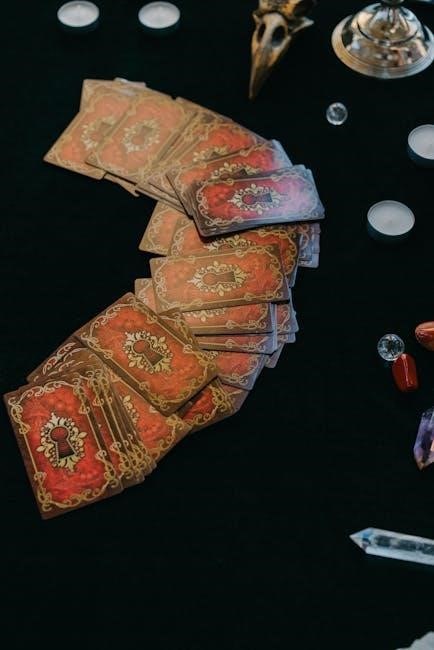Cartomancy is an ancient practice of divination using a standard deck of 52 playing cards. It offers insights into past, present, and future, blending intuition with card symbolism. This accessible form of fortune-telling is similar to tarot but uses familiar playing cards, making it a popular choice for beginners and seasoned practitioners alike.
What is Cartomancy?
Cartomancy is a form of divination that uses a standard deck of 52 playing cards to gain insights into the past, present, and future. Unlike tarot, it relies on a familiar deck, making it accessible to everyone; The practice involves interpreting the symbolism of the cards, including suits, numbers, and court cards, to uncover hidden truths. Each card carries specific meanings, with suits representing different life categories, such as emotions (hearts), material wealth (diamonds), social interactions (clubs), and challenges (spades). Numbered cards often signify events, while court cards represent people or personalities. By tapping into intuition and universal energy, cartomancy provides a powerful tool for self-discovery and guidance, helping individuals navigate life’s complexities with clarity and purpose. Its simplicity and depth make it a popular choice for both beginners and experienced practitioners.
The History of Cartomancy
Cartomancy, the art of divination using playing cards, has roots tracing back to the 18th century in Europe. It evolved alongside tarot, sharing similar symbolic interpretations but using a standard deck. The practice gained popularity as a more accessible alternative to tarot, especially among those unfamiliar with tarot’s complex imagery. Over time, cartomancy developed its own traditions, blending intuition with card meanings. Its flexibility allowed it to adapt across cultures, making it a enduring form of fortune-telling. Today, cartomancy remains a popular method for seeking guidance, offering insights into life’s challenges and opportunities. Its rich history highlights its versatility and enduring appeal as a tool for self-discovery and divination.
Cartomancy vs. Tarot: Key Differences
While both cartomancy and tarot use cards for divination, they differ in structure and interpretation. Tarot decks typically have 78 cards with detailed symbolism, divided into Major and Minor Arcana. Cartomancy uses a standard 52-card playing deck, focusing on suits and numbers. Tarot often explores deeper, spiritual themes, whereas cartomancy offers more straightforward, practical insights. Tarot readings may involve complex spreads, while cartomancy tends to be more flexible and accessible. Despite these differences, both practices rely on intuition and personal connection to the cards, making them unique yet complementary tools for self-discovery and guidance.

The Basics of Cartomancy
Cartomancy is a form of divination using a standard 52-card deck. It interprets suits, numbers, and court cards, guided by intuition and universal energy flows.
Understanding the Suits in Cartomancy
In cartomancy, the four suits—Hearts, Diamonds, Clubs, and Spades—each represent different aspects of life. Hearts symbolize emotions, relationships, and love, often reflecting personal matters. Diamonds are linked to finances, career, and material success, highlighting practical concerns. Clubs represent friendships, community, and new opportunities, emphasizing social interactions. Spades are associated with challenges, decisions, and transformation, often indicating change or conflict. Understanding these suit meanings is crucial for interpreting card readings, as they provide context for the specific cards drawn. By aligning each suit with its corresponding life category, practitioners can delve deeper into the symbolism and guidance offered by the cards.
Hearts: Meanings and Interpretations
In cartomancy, Hearts are deeply connected to emotions, relationships, and matters of the heart. They often represent love, harmony, and joy but can also signify emotional challenges or personal conflicts. A Hearts card typically reflects how you feel about a situation or how others feel about you. For example, the Ace of Hearts symbolizes new love or emotional renewal, while the King of Hearts suggests stability and emotional support. Numbered Hearts cards, like the 3 of Hearts, can indicate celebrations or emotional fulfillment, while reversed Hearts may signal heartbreak or unrequited love. By tuning into the emotional resonance of Hearts, practitioners can gain insights into personal relationships and inner feelings, making this suit a cornerstone of cartomancy readings focused on love and emotional well-being.
Diamonds: Meanings and Interpretations
Diamonds in cartomancy are associated with material wealth, career, and financial success. They often symbolize practicality, ambition, and tangible achievements. A Diamond card can indicate monetary gains, career advancements, or challenges related to financial stability. For instance, the Ace of Diamonds typically represents new opportunities or financial windfalls, while the King of Diamonds may signify a mentor or authority figure in your professional life. Numbered Diamond cards, such as the 5 of Diamonds, can reflect hard work, progress, or setbacks in projects. Diamonds also tap into your intuition about financial decisions and career paths, offering guidance on how to navigate practical matters effectively. By interpreting Diamonds, practitioners can uncover insights into their material success and how to align their actions with their goals.
Clubs: Meanings and Interpretations
In cartomancy, Clubs are linked to creativity, community, and communication. They symbolize social interactions, new ideas, and collaborative efforts; A Club card often represents opportunities for growth through relationships or group activities. For example, the Ace of Clubs may signify a fresh creative project or invitation, while the King of Clubs could represent a wise mentor or influential friend. Numbered Club cards, such as the 3 of Clubs, might indicate celebrations, teamwork, or shared successes. Clubs also reflect themes of learning, inspiration, and personal growth. By interpreting Clubs, practitioners can gain insights into how social dynamics and creative endeavors influence their lives. These cards encourage fostering connections and embracing opportunities for collaboration and innovation.
Spades: Meanings and Interpretations
In cartomancy, Spades are associated with challenges, change, and inner reflection. They often symbolize difficult decisions, emotional struggles, or mental clarity. Spades can represent transformation, highlighting the need to let go of outdated patterns or beliefs. For example, the Ace of Spades may signify a fresh start or a major life shift, while the King of Spades could represent a figure of authority or a call to take control of a situation. Numbered Spades, such as the 5 of Spades, often indicate conflict or tension that must be resolved. Overall, Spades encourage introspection and resilience, guiding individuals to navigate challenges and emerge stronger. They remind us that growth often arises from facing adversity head-on.

Court Cards in Cartomancy
Court cards symbolize key figures and events. Kings represent authority, Queens embody nurturing, and Knaves/Jacks often denote messages or young individuals, reflecting personal interactions and circumstances.
Kings: Their Role and Meaning
Kings in cartomancy are powerful symbols of authority, leadership, and mastery. They often represent influential figures in one’s life, such as a father, boss, or partner, who embody strength and wisdom. Depending on the suit, a King can signify different areas of influence: Hearts for emotional matters, Diamonds for financial success, Clubs for social or community leadership, and Spades for challenges or conflicts. Their presence in a reading suggests a need for structure, decision-making, and taking charge of a situation. Kings can also indicate major life events, such as a significant achievement or the arrival of an important message. Their energy is commanding and often calls for assertiveness and clarity in action.
Queens: Their Role and Meaning
Queens in cartomancy embody femininity, intuition, and nurturing energy. They often symbolize influential women in one’s life, such as a mother, partner, or close friend, who bring emotional support and wisdom. Each Queen corresponds to a suit, reflecting specific areas of influence: Hearts for love and relationships, Diamonds for financial or material matters, Clubs for social connections or community, and Spades for challenges or emotional depth. Queens can represent the querent themselves, offering guidance to trust their instincts and embrace their inner strength. Their presence in a reading suggests a need for balance, compassion, and thoughtful decision-making. Queens also highlight the importance of self-care and creating harmony in personal or professional spheres.
Knaves/Jacks: Their Role and Meaning
In cartomancy, Knaves (also known as Jacks) are often seen as messengers or representatives of change and new opportunities. They symbolize communication, decisions, and the arrival of fresh perspectives. Knaves typically represent younger males or individuals who may influence the querent’s life, bringing either positive or challenging energy. Their appearance in a reading can signify a need for action, adaptability, or paying attention to messages from others. Knaves are also associated with curiosity, exploration, and the pursuit of knowledge. They encourage the querent to embrace new experiences and trust their instincts when faced with choices. Whether the Knave appears as a person, an event, or a prompt for self-reflection, their role is to spark movement and awareness in the querent’s journey.

Number Cards in Cartomancy
Number cards in cartomancy, from 2 to 10, represent specific events, numerological influences, and life circumstances. They provide detailed insights into the querent’s situation and future.
Ace Cards: Their Significance
Ace cards in cartomancy hold profound significance, symbolizing new beginnings, opportunities, and fresh starts. They often represent the potential for growth and change in various areas of life. Each Ace corresponds to a specific suit, with the Ace of Hearts linked to emotional matters, Diamonds to financial or material ventures, Clubs to social or communal endeavors, and Spades to challenges or transformations. Drawing an Ace suggests that a new cycle is about to commence, urging the querent to embrace possibilities and make conscious decisions; Aces are powerful indicators of innovation and renewal, offering a clean slate for personal and professional development.
Numbered Cards (2-10): Their Meanings
Numbered cards (2-10) in cartomancy represent specific life events, challenges, or transitions. Each number carries its own symbolism, reflecting progress, choices, or completion. The 2 often signifies balance or decisions, while the 3 represents creativity or growth. Mid-range numbers like 5 and 6 may indicate change or stability, respectively. Higher numbers, such as 8 and 9, symbolize progress toward goals or nearing completion. The 10 typically signifies fulfillment or the end of a cycle. Interpretations vary by suit, with Hearts focusing on emotions, Diamonds on finances, Clubs on social matters, and Spades on challenges. These cards provide insights into everyday situations, guiding the querent to navigate their path effectively and make informed decisions. They are practical tools for understanding current circumstances and potential outcomes.

How to Perform a Cartomancy Reading
Cartomancy readings involve preparing the deck, shuffling, cutting, and drawing cards. Interpret revealed cards based on their suits, numbers, and intuition, connecting them to the querent’s energy and question.
Preparing for a Reading
Preparing for a cartomancy reading involves centering yourself and creating a conducive environment. Begin by cleansing the deck with a clear intention or a quick prayer to remove negative energy. Shuffle the cards gently, focusing on the question at hand; This helps align the deck with the querent’s energy. Some practitioners also recommend cutting the deck to enhance clarity. Ensure the space is quiet and free from distractions, fostering a calm atmosphere for intuition to flow. Trust your inner voice and allow the cards to guide you. Keep an open mind, as cartomancy relies on interpreting symbols and energies embedded in the cards. Proper preparation enhances the accuracy and depth of the reading, making it a meaningful experience for both the reader and the querent.
Shuffling and Cutting the Deck
Shuffling and cutting the deck are integral steps in cartomancy, ensuring the cards align with the querent’s energy. Begin by shuffling the deck thoroughly, focusing on the question or intention. This process mixes the cards, breaking their previous order and infusing them with your intent. Some practitioners prefer a specific shuffling technique, such as riffling or overhand shuffling, to enhance the connection. After shuffling, the deck is typically cut by the querent or the reader, often into three piles, symbolizing the past, present, and future. The act of cutting allows the querent to imprint their energy on the deck. The cards are then rearranged, and the top card(s) are drawn for interpretation. This ritualistic process prepares the deck for an accurate and meaningful reading, ensuring the cards reflect the querent’s situation and guidance.
Interpreting the Cards
Interpreting the cards in cartomancy involves a combination of intuition, symbolism, and the querent’s energy. Each card holds specific meanings, influenced by its suit, number, and position in the spread. The querent’s question or intention guides the interpretation, as the cards reflect their unique situation. Pay attention to patterns, such as recurring suits or court cards, which highlight dominant themes or individuals. Number cards often signify events or timelines, while court cards represent people or personality traits. Trust your intuition to connect the dots between the cards and the querent’s life; The interpretation should be fluid, considering the card’s position and its relationship with others in the spread; This intuitive process allows the reader to uncover hidden insights and provide meaningful guidance.

Advanced Techniques in Cartomancy
Advanced cartomancy techniques involve complex spreads, card combinations, and intuitive connections. These methods deepen insights, revealing layered meanings and subtle energies, enhancing the precision of readings.
Using Spreads in Cartomancy
Spreads are essential in cartomancy, offering structured layouts to explore specific questions or themes. Each position in a spread holds a unique meaning, guiding the interpretation of drawn cards. Whether simple or complex, spreads like the Three-Card Spread or Celtic Cross provide frameworks for deeper insights. They help practitioners connect card symbolism with the querent’s situation, revealing past influences, current challenges, and future outcomes. By using spreads, cartomancers can uncover hidden patterns and relationships, enhancing the accuracy and depth of readings.
Combining Cards for Deeper Insights
Combining cards in cartomancy allows for a richer understanding of a situation, revealing intricate connections and patterns. By interpreting multiple cards together, practitioners can uncover relationships between events, emotions, and individuals. This method enhances the depth of readings, offering a more holistic view of the querent’s circumstances. Card combinations often highlight themes, challenges, and potential outcomes, providing clarity and guidance. Intuition plays a key role in synthesizing the meanings of grouped cards, as their interaction can reveal subtle influences and dynamics. Over time, practitioners develop the skill to weave individual card meanings into a cohesive narrative, making cartomancy a powerful tool for self-discovery and decision-making.

Resources for Further Learning
Explore books like “Fifty-four Devils” and “The Card Readers Handbook.” Join online forums such as Reddit and Facebook groups dedicated to cartomancy for deeper exploration.
Recommended Books on Cartomancy
For deeper insight, explore books like Fifty-four Devils, a great guide for beginners, and The Card Readers Handbook by Regina Russell, offering practical tips. Fortune Telling by Playing Cards by Nerys Dee is another excellent resource, providing detailed card meanings and techniques. These books offer comprehensive guidance, helping you master cartomancy and enhance your readings. They blend historical context with modern practices, making them invaluable for both newcomers and experienced practitioners. Whether you’re seeking to understand card symbolism or refine your interpretation skills, these texts are essential additions to your cartomancy journey. Dive into these recommended reads to expand your knowledge and deepen your connection with the cards.
Online Communities and Forums
Joining online communities and forums is a great way to deepen your cartomancy practice. Platforms like Reddit and specialized spiritual forums offer spaces to connect with practitioners, share insights, and learn from others. Websites such as the Internet Archive preserve historical documents and guides, providing invaluable resources for study. Many online groups host discussions on card meanings, spreads, and techniques, while others share personal experiences and tips for refining your skills. Engaging with these communities can help you gain new perspectives and stay updated on modern approaches to cartomancy. Whether you’re seeking advice or looking to expand your knowledge, these online spaces are a valuable resource for every level of practitioner.
